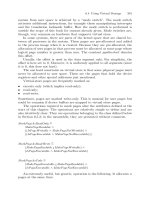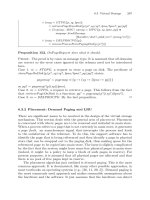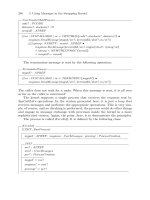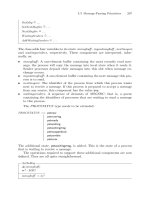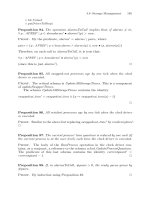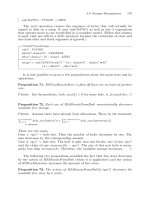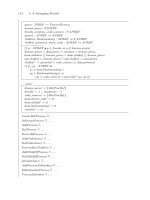Formal Models of Operating System Kernels phần 8 pot
Bạn đang xem bản rút gọn của tài liệu. Xem và tải ngay bản đầy đủ của tài liệu tại đây (285.02 KB, 31 trang )
236 5 Using Messages in the Swapping Kernel
UserCreateChildProcess
code ?:PCODE
datasize?, stacksize?:N
newpid!:APREF
(∃ m : SYSCALLMSG | m = CRTCHLD code ?, stacksize?, datasize? •
msgman.SendMessage[mypid/src?, kernintfid/dest?, m/m?])
o
9
(∃ rpmsg : SYSRPY ; newid : APREF •
msgman.RcvMessage[kernintfid /src!, mypid/dest?, rpmsg/m!]
∧ rpmsg = NEWCHLDPROC newid
∧ newpid !=newid)
The termination message is sent by the following operation:
TerminateProcess
mypid?:APREF
(∃ m : SYSCALLMSG | m = TERMPROC mypid? •
msgman.SendMessage[mypid/src?, kernintfid/dest?, m/m?])
The caller does not wait for a reply. When this message is sent, it is all over
as far as the caller is concerned!
The kernel supports a single process that receives the requests sent by
SysCallLib’s operations. In the version presented here, it is just a loop that
receives messages and performs the appropriate operations. This is very sim-
ple, of course, and no checking is performed; the process could do other things
and engage in message exchange with processes inside the kernel in a more
sophisticated version. Again, the point, here, is to demonstrate the principles.
The process is called KernIntf. It is defined by the following class:
KernIntf
(INIT , RunProcess)
mypid : APREF ; msgman : UserMessages; procmgr : ProcessCreation
INIT
me?:APREF
mm?:UserMessages
pcr ?:ProcessCreation
mypid
= me?
msgman
= mm?
procmgr
= pcr ?
5.6 Kernel Interface 237
RunProcess =
∀ i :1 ∞•
(∃ m : SYSCALLMSG •
msgmgr.RcvMessage[mypid/cal ler ?, src/src?, m/m!]
∧ ((∃ src : APREF ; stcksz , datasz : N;
code : MEM ; newpid : APREF •
m = CRTPROC src, code , stcksz, datasz
∧ procmgr.CreateUserProcess
[code /code ?, stcksz/stacksize?,
datasz/datasize?, newpid/newpid!]
∧ (∃ crmsg : SYSRPY | crmsg = NEWPROC newpid •
msgmgr.SendMsg[mypid/src?, src/dest?, crmsg/m?]))
∨ (∃ src : APREF ; stcksz , datasz : N;
code : MEM ; newpid : APREF •
m = CRTCHLD src, code , stcksz , datasz
∧ procmgr.CreateChildUserProcess
[code /code ?, stcksz/stacksize?, datasz/datasize?,
src/rqprocid ?, newpid/newpid!]
∧ (∃ retmsg : SYSRPY |
retmsg = NEWCHLDPROC newpid •
msgmgr.SendMsg[mypid/src?, src/dest?, retmsg /m?]))
∨ (∃ tpid : APREF •
m = TERMPROC tpidsrc
procmgr .TerminateProcess[tpid/p?])
∨ ))
The class is incomplete because it does not handle any requests other than
user-process creation and termination. With the exception of sending and
receiving messages, the kernel does not contain any other services that would
be useful to user processes. The message-passing operations are not included
because they are obvious given the above definitions.
It is now possible to state an important proposition about the kernel.
Proposition 123. Only one user process can be in the kernel at any one time.
Proof. First, it is necessary to clarify what is meant by the statement of the
proposition. What is intended by the proposition is the following: at any one
time, it is possible for at least one and at most one system call to be processed.
Since system calls are: (i) procedure calls and (ii) requests for the kernel to
perform some action (as defined by the system call library, SysCallLib, as the
sketch-form adopted here is called).
As a procedure call, any system call can belong to a single thread of exe-
cution only. This implies that exactly one process at a time can be performing
the system call.
238 5 Using Messages in the Swapping Kernel
The procedures comprising the system-call library all send and receive
messages. Therefore, the rest of the proof must be in terms of the properties
of the message-passing subsystem.
The message-passing subsystem is driven by interrupts (Proposition 116)
and only one interrupt can be serviced at any time (this is an informal property
of interrupts). Therefore, while any user process is sending (or receiving) a
message, there can be no other process performing the same operation (more
generally, there can be no other process performing any operation).
By Proposition 114, messages are processed in the order in which they are
received. By inspection of the system-call operations, each is structured as a
message send followed by a message receive. Furthermore, message passing is
synchronous by Proposition 112.
The system calls are implemented by a process that just waits for messages,
services them and returns the reply. Therefore, until a system call has been
completed, it is not possible for the caller to proceed. Furthermore, by the
organisation of the message-passing subsystem, it is not possible for another
user process to proceed until the KernIntf process has replied to a message.
The remainder of the kernel will have its operations hidden by syntactic
methods and only imported by the KernIntf process. ✷
Corollary 10. Message passing can be used to implement mutual exclusion.
Proof. By Propositions 112 and 114. ✷
6
Virtual Storage
Nil posse creari de nilo
– Lucretius, De Rerum Natura, I, 155
6.1 Intro duction
In this chapter, mechanisms to support virtual storage will be modelled. Vir-
tual storage affords a considerable number of advantages to the operating
system designer and user. Virtual storage is allocated in units of a page and
pages can be collected into independent segments; virtual storage defines clear
boundaries between address spaces so that each process can maintain its own
address space. This clearly provides a measure of protection between processes
but requires additional methods for exchanging data between processes.
In virtual storage systems, main store is shared between processes in the
usual way but is defined as a sequence of page frames, each a block of store
one page long. The storage belonging to each process is swapped into main
store when required and copied to a paging disk (or some other mass-storage
device) when not required. Strategies for selecting pages to copy to the paging
disk and for determining which page to bring into main store must be defined.
6.2 Outline
The storage system to be designed is to have the following features:
• The virtual store should have four segments: one each for code, data, stack
and heap.
• The system uses demand paging with reference counting for victim selec-
tion.
• Pages can be shared (and unshared) between processes.
• Segments can be shared (and unshared) between processes;
240 6 Virtual Storage
• Storage should be mapped in the sense that disk blocks can be directly
mapped to main-store pages and vice versa.
• Message passing will be used for IPC.
The virtual storage system is composed of:
• A page-fault handler. This is invoked when a page fault occurs. It deter-
mines the identity of the logical page that caused the page fault. It invokes
the page-fault driver process and passes to it the identifier of the faulting
process and the page number. It unreadies the faulting process.
• A page-fault driver. This takes a message from the page-fault ISR and
sends a message to the paging disk to retrieve the page whose reference
caused the fault. If there are no free page frames in (main) physical store,
it selects a victim page in physical store and sends it to the paging disk.
When the faulting page is received from the paging disk, it is copied into a
main store page whose physical address is identified with the logical page
number in the faulting process. The faulting process is then readied and
the driver waits for the next page fault.
The above scheme is sub-optimal. As part of the model, optimisations
are suggested, particularly for the interactions between the driver and paging
disk.
Even though it is sub-optimal, the above scheme is logically sufficient. It is,
therefore, appropriate to concentrate on it as the model for this chapter. This
exemplifies the method adopted in this book: capturing the logical functioning
of the model is much more important than optimisation. The optimisation
included here is introduced as an example of how it can be done without too
much of a compromise to the model.
The structure of this kernel is shown in Figure 6.1. Comparison of this
figure with the corresponding one in Chapter 4 (Figure 4.1) reveals their
similarities. In the current kernel, virtual and not real storage forms the basis
of the system. Apart from the need for structures and operations to support
virtual storage (the subject of this chapter), the main difference lies in the
kernel bootstrapping operations (which are not considered in this book).
6.3 Virtual Storage
In this section, the basic structures required to model a virtual store are
introduced.
The following axiomatic definition defines the number of real pages (pages
in real store or physical pages) and the size of the page frame. Neither constant
is assigned a value, so the specification is of the loose variety.
numrealpages : N
framesize : N
The basic virtual address is represented by an atomic type:
6.3 Virtual Storage 241
ISR ISRTLB Clock
IPC
Process Abstraction
V-Store Manager
i/o r/gs
System
Calls
User
Processes
alarms
Context
Switch
Process
Table
Device
Processor
Page
Tables
Physical
Store Mgr.
Kernel Interface
Routines
Paging
Disk
Process
Page
Placement
Clock
Process
Low-Level
Scheduler
Page Fault
ISRs
Kernel
Primitive
System
Processes
Pages locked in store
(Always resident)
Pages not locked in store
(Temporarily resident)
……
Fig. 6.1. The layer-by-layer organisation of the kernel, including virtual storage-
management modules.
242 6 Virtual Storage
[VIRTUALADDRESS ]
maxvirtpagespersegment : N
This is the maximum number of virtual pages that a process can own.
PAGEOFFSET == 1 framesize
PHYSICALPAGENO == 1 numrealpages
LOGICALPAGENO == N
where:
• PAGEOFFSET denotes the offsets into a page;
• PHYSICALPAGENO denotes the indices of pages in the main-store page
frame;
• LOGICALPAGENO denotes the indices of logical pages (pages belonging
to a process).
Note that LOGICALPAGENO is not bounded above. The reason for this is
that the actual number of logical pages that a process can have is a hardware-
dependent factor and is not relevant to the current exercise.
For every virtual address, the hardware performs an address translation
that maps the virtual address to a logical frame number and an offset into
that frame. The signature of this function, addresstrans,is:
addresstrans : VIRTUALADDRESS → DECODEDADDRESS
The definition of this function is hardware-specific and is, in any case, not
particularly relevant to the current exercise.
The type DECODEDADDRESS is defined as:
DECODEDADDRESS == LOGICALPAGENO × FRAMEOFFSET
and has the following projections:
dlogicalpage : DECODEDADDRESS → LOGICALPAGENO
dpageoffset : DECODEDADDRESS → PAGEOFFSET
∀ addr : DECODEDADDRESS •
dlogicalpage(addr)=fst addr
dpageoffset(addr)=snd addr
For a segmented, paged architecture, the address-decoding function can
be defined as:
saddresstrans : VIRTUALADDRESS → SDECODEDADDRESS
where:
6.3 Virtual Storage 243
SDECODEDADDRESS == SEGMENT × LOGICALPAGENO × PAGEOFFSET
and:
saddrseg : SDECODEDADDRESS → SEGMENT
spageno : SDECODEDADDRESS → LOGICALPAGENO
spagoffset : SDECODEDADDRESS → PAGEOFFSET
∀ saddr : SDECODEDADDRESS •
saddrseg(saddr)=fst saddr
spageno(saddr)=fst(snd saddr)
spagoffset(saddr)=snd
2
saddr
The PAGEMAP translates logical to physical page numbers. PAGE-
FRAME translates physical page numbers to the actual pages in store. Finally,
PAGE defines a storage page as a vector of PSU ; the vector has PAGEOFF-
SET elements. (PSU is, it will be recalled, the Primary Storage Unit,which
is assumed to be a byte.)
PAGEMAP == LOGICALPAGENO → PHYSICALPAGENO
PAGEFRAME == PHYSICALPAGENO → PAGE
PAGE == PAGEOFFSET → PSU
The empty page is defined as follows:
NullPage : PAGE
NullPage =(λ i : PAGEOFFSET • 0)
It is a page (vector of bytes), PAGEOFFSET bytes long, with each byte set
to zero.
Pages are associated with a number of flags, including, among others:
• in core (i.e., in main store);
• locked In (i.e., must always remain in main store);
• shared (i.e., shared between at least two processes).
For each process, these properties can be represented by sets (thus simplifying
the modelling of pages).
For the remainder of this section, a segmented virtual store will be mod-
elled. The hardware nearest to the model presented here is the Intel X86
series. The reader is warned that this is a logical model of segmented, paged
storage, not an exact rendition of any existing hardware implementations.
Furthermore, details such as the Translation Lookaside Buffer,orTLB, (the
associative store that typically holds a few entries from the current process’
page table) are not modelled in detail, the reason being that, as usual, hard-
ware differs considerably in implementation and, in particular, the size of the
TLB can vary considerably among MMUs
1
.
1
Memory Management Unit.
244 6 Virtual Storage
Although most segmented hardware supports more than four segments
per process, for the present, only three segments will be considered. Linux on
X86 requires three segments: one each for code, stack and data, although the
hardware permits a maximum of 16 segments (the virtual address size is 32
bits). The segment names are as follows:
SEGMENT == {code, data, stack, heap, }
A great many programming languages now require heap (dynamic) storage.
A problem for dynamic store, as with stacks, is that, quite frequently, it has
to be expanded. Within a three-segment organisation, the heap is part of
either the stack or data segment; this can limit the maximum size of the
heap somewhat on 32-bit machines. To simplify manipulation, it is assumed
here that the data segment contains static data (global variables, literal pools,
fixed-length buffers and so on) and the heap is given its own segment. The
heap can, therefore, grow to the maximum segment size at runtime, as can
the stack segment.
usedsegment : SEGMENT
∀ s : SEGMENT •
usedsegment(s) ⇔ s ∈{code, data, stack, heap}
It is now possible to define per-process page tables.
Each segment is composed of a number of pages. The following function
translates a physical address and segment into a logical page number:
pages in segment : APREF × SEGMENT ×
(APREF → SEGMENT → F LOGICALPAGENO) →
F LOGICALPAGENO
∀ p : APREF ; sg : SEGMENT ; f : APREF → SEGMENT →
F LOGICALPAGENO •
pages in segment(p, sg, f )=f (p)(sg)
The following (inverse) functions mark and unmark pages. They are
higher-order functions that take the specification of a page and a page at-
tribute map as arguments and return the modified page attribute map.
mark page : APREF × SEGMENT × LOGICALPAGENO×
(APREF → SEGMENT → F LOGICALPAGENO) →
(APREF → SEGMENT → F LOGICALPAGENO)
unmark page : APREF × SEGMENT × LOGICALPAGENO×
(APREF → SEGMENT → F LOGICALPAGENO) →
(APREF → SEGMENT → F LOGICALPAGENO)
∀ p : APREF ; sg : SEGMENT ; lpno : LOGICALPAGENO;
f : APREF → SEGMENT → F LOGICALPAGENO •
mark page (p, sg, lpno, f )=f (p) ⊕{sg → (f (p)(sg) ∪{lpno})}
unmark
page (p, sg, lpno, f )=f (p) ⊕{sg → (f (p)(sg) \{lpno})}
6.3 Virtual Storage 245
It is now proved that these two functions are mutual inverses.
Proposition 124. mark
page and unmark page
−1
are mutually inverse.
Proof. Write f (p)(sg)=h, then:
mark = f (p) ⊕{sg → (h ∪{lpno})}
unmark = f (p) ⊕{sg → (h \{lpno})}
Calculating the value of unmark ◦ mark, we obtain:
(f (p) ⊕{sg → (h ∪{lpno})}) ⊕{sg → (h \{lpno})}
Writing f (p)(sg)=s,thenmark = s ∪{lpno} and unmark = s \{lpno},so:
unmark ◦ mark
=(s \{lpno}) ◦ (s ∪{lpno})
=(s ∪{lpno}) \{lpno}
= s
Conversely:
mark ◦ unmark
=(s ∪{lpno}) ◦ (s \{lpno})
=(s \{lpno}) \{lpno}
= s
Therefore, mark and unmark are mutual inverses and the proposition is
proved. ✷
The page table abstraction can be modelled as follows. The variable free-
pages represents those pages in main store that are not allocated to any
process. The page table proper is pagetable. The variables executablepages,
writablepages and readablepages are intended to refer to pages the owner has
marked executable (i.e., code pages), read-only (e.g., a constant data seg-
ment) and read-write (e.g., a stack). Pages can be shared between processes
and some are locked into main store. When a page is locked, it cannot be
removed from main store. The kernel’s own storage is often marked as locked
into main store. It is so locked because a page fault could prevent the kernel
from responding in time to a circumstance. It is also necessary to keep track
of those pages that are currently in main store: these are referred to as being
“in core”, hence the name of the variable, incore.Thepagecount counts the
number of pages in each segment of each process. There is an a priori limit to
the number of pages in a segment and pagecount is intended to keep track of
this and to provide a mechanism for raising an error condition if this limit is
exceeded. The final variable, smap, is a relation between elements of PAGE-
SPEC ; it denotes those pages that are shared and it will be explained in more
detail below.
246 6 Virtual Storage
There are different ways to organise page tables. The simplest is a linear
sequence of page references. As virtual storage sizes increase, simple linear
structures do not perform well, so tree-like structures are to be preferred.
These trees can be arranged to perform mapping on two or three levels. The
model defined here is intended to be suggestive of a tree structure, even though
it can also be implemented as a table.
The class that follows defines an abstract data type. It represents the page
table type. The type exports a large number of operations and has the most
complex invariant in this book.
PageTables
(INIT , HaveFreePages, NumberOfFreePages, AllocateFreePage ,
MakePageFree, PhysicalPageNo, InitNewProcessPageTable,
RemoveProcessFromPageTable, AddPageToProcess, HasPageInStore,
IncProcessPageCount, DecProcessPageCount,
LatestPageCount, UpdateMainstorePage,
RemovePageFromProcessTable, RemovePageProperties,
RemovePageFromProcess, IsPageInMainStore, MarkPageAsIn,
MarkPageAsOut, IsSharedPage, MarkPageAsShared,
UnsharePage, IsLockedPage, LockPage, UnlockPage,
MakePageReadable, MakePageNotReadable, MakePageExecutable,
IsPageExecutable, MakePageNotExecutable, MakePageWritable,
IsPageWritable, MakePageNotWritable)
freepages : F PHYSICALPAGENO
pagetable : APREF → SEGMENT → PAGEMAP
executablepages, writablepages, readablepages,
sharedpages, lockedpages,
incore : APREF → SEGMENT → F LOGICALPAGENO
pagecount : APREF → SEGMENT → N
smap : PAGESPEC ↔ PAGESPEC
InvPageTables
0 ≤ #freepages ≤ numrealpages
dom incore ⊆ dom pagetable
dom sharedpages ⊆ dom pagetable
dom lockedpages ⊆ dom pagetable
dom pagecount = dom pagetable
dom executablepages = dom pagetable
dom writablepages = dom pagetable
dom readablepages = dom pagetable
6.3 Virtual Storage 247
INIT
freepages
= ∅
dom pagetable
= ∅
dom sharedpages
= ∅
dom lockedpages
= ∅
dom incore
= ∅
dom pagecount
= ∅
dom executablepages
= ∅
dom writablepages
= ∅
dom readablepages
= ∅
dom smap = ∅
HaveFreePages =
NumberOfFreePages =
Al locateFreePage
=
MakePageFree =
PhysicalPageNo =
InitNewProcessPageTable =
RemoveProcessFromPageTable =
AddPageToProcess =
HasPageInStore = IncProcessPageCount =
DecProcessPageCount =
LatestPageCount =
UpdateMainstorePage =
RemovePageFromPageTable
=
RemovePageProperties =
RemovePageFromProcess =
IsPageInMainStore =
MarkPageAsIn
=
MarkPageAsOut =
IsSharedPage
=
MarkPageAsShared =
UnsharePage =
IsLockedPage
=
LockPage =
UnlockPage =
248 6 Virtual Storage
MakePageReadable =
MakePageNotReadable =
MakePageExecutable =
IsPageExecutable =
MakePageNotExecutable =
MakePageWritable =
IsPageWritable =
MakePageNotWritable =
It will be noted that the invariant is partially stated in the class definition.
The remainder is specified by the InvPageTables schema defined below after
the other operations have been defined. This will bring the invariant closer to
some of the proofs in which it is required.
The following schema represents the test that there are pages in main store
(physical pages) that are free.
HaveFreePages
freepages = ∅
NumberOfFreePages
np!:N
np!=#freepages
The following operation models the allocation of a free page to a process.
It removes the page denoted by ppno! from the set of free pages, freepages.
Al locateFreePage
∆(freepages)
ppno!:PHYSICALPAGENO
ppno! ∈ freepages
freepages
= freepages \{ppno!}
Proposition 125. AllocateFreePage implies that #freepages
= freepages+1.
Proof.
#freepages
=#(freepages \{ppno?})
=#freepages − #{ppno?}
=#freepages − 1
✷
6.3 Virtual Storage 249
Proposition 126. If freepages = n, AllocateFreePage
n
implies freepages
=
0.
Proof. By induction, using the last proposition. ✷
The next operation returns a page to the set of free pages.
MakePageFree
∆(freepages)
ppno?:PHYSICALPAGENO
freepages
= freepages ∪{ppno?}
Proposition 127. MakePageFree implies that #freepages
=#freepages − 1.
Proof.
#freepages
=#(freepages ∪{ppno?})
=#freepages +#{ppno?}
=#freepages +1
✷
Proposition 128. AllocateFreePage[p/ppno!]
o
9
MakePageFree[p/ppnp?] im-
plies that freepages
= freepages.
Proof. The sequential composition can be written as:
∃ freepages
: F PHYSICALPAGENO | freepages
= freepages \{ppno!}•
freepages
= freepages ∪{ppno?}
Renaming and simplifying:
freepages
=(freepages \{p}) ∪{p}
Then:
(freepages \{p}) ∪{p}
=(freepages \{p}) ∪{p}
= freepages ∪ ({p}\{p})
= freepages ∪ ∅
= freepages
✷
The PhysicalPageNo operation contains a use of the pagetable variable.
This variable is a higher-order function. Its use might appear a little odd.
250 6 Virtual Storage
Essentially, to obtain the physical page number corresponding to a logical
page number, the process has to locate the segment in which the page occurs
and then translate the logical page number.
PhysicalPageNo
p?:APREF
sg?:SEGMENT
lpno?:LOGICALPAGENO
ppgno!:PHYSICALPAGENO
ppgno!=pagetable(p?)(sg?)(lpno?)
When a process is allocated, it is given an entry in the page table. The
following schema models this operation. It just adds the process’ identifier as
a key in the subtables and sets everything to zero (empty or ∅).
InitNewProcessPageTable
∆(incore, sharedpages, lockedpages)
p?:APREF
pagetable
= pagetable ∪{p? → code → ∅}∪{p? → data → ∅}
∪{p? → stack → ∅}∪{p? → heap → ∅}
incore
=(incore ∪{p? → code → ∅}) ∪ ({p? → data → ∅}
(∪{p? → stack → ∅}(∪{p? → heap → ∅})))
sharedpages
=(sharedpages ∪{p? → code → ∅}) ∪ ({p? → data → ∅}
(∪{p? → stack → ∅}(∪{p? → heap → ∅})))
lockedpages
=(lockedpages ∪{p? → code → ∅}) ∪ ({p? → data → ∅}
(∪{p? → stack → ∅}(∪{p? → heap → ∅})))
Proposition 129. InitNewProcessPageTable implies that the new process has
no pages.
Proof. For a process to have pages, it must have at least one page
in at least one segment. However, for a process, p, and all segments, sg,
pagetable
(p)(sg)=∅. ✷
Corollary 11. InitNewProcessPageTable implies that the new process has no
in-core pages.
Proof. Similar to the above. ✷
Similar results can be proved for all other page attributes, e.g., locked
pages.
Conversely, when a process terminates or is killed, its storage is returned
to the free pool and all of the information associated with it in the page tables
is removed. The following schema models this operation:
6.3 Virtual Storage 251
RemoveProcessFromPageTable
∆(pagetable, incore, sharedpages, lockedpages)
p?:APREF
pagetable
= {p?}
−
pagetable
incore
= {p?}
−
incore
sharedpages
= {p?}
−
sharedpages
lockedpages
= {p?}
−
lockedpages
Proposition 130. The predicate of RemoveProcessFromPageTable implies
that p ∈ dom pagetable.
Proof. The first line of the predicate is pagetable
= {p?}
−
pagetable. Taking
domains:
dom pagetable
= dom({p?}
−
pagetable)
= (dom pagetable) \{p?}
✷
Proposition 131. For any p : APREF , RemoveProcessFromPageTable[p/p?]
implies that the process:
1. is no longer incore, swappable, etc.; and
2. is no longer in the page table for its owning process.
Proof. Each conjunct of the predicate employs the domain subtraction op-
eration (
−
)toremovep from the domain of each function. This implies that
p is removed from each table. ✷
Propositions about page attributes can be proved. They follow the pattern
of the last proposition.
When the storage image of a process is augmented by the addition of fresh
pages, the following operation is the basic one used to extend the process’
page table entry. Each page is specified as a process reference, a segment and
a logical page number; in addition, the physical page number of the page to be
added is also included. Since the process and segment are already present in
the table, the logical to physical page number mapping is added to the table
at the specified point.
AddPageToProcess
∆(pagetable)
p?:APREF
sg?:SEGMENT
lpno?:LOGICALPAGENO
ppno?:PHYSICALPAGENO
pagetable
= pagetable(p?)(sg?) ∪{lpno? → ppno?}
252 6 Virtual Storage
There now follows a predicate that returns true when the process specified
by p? has at least one page in main store:
HasPageInStore
p?:APREF
p? ∈ dom incore
The per-segment page count is incremented by the following schema:
IncProcessPageCount
∆(pagecount )
p?:APREF
sg?:SEGMENT
pagecount
= pagecount(p?) ⊕{sg? → pagecount (p?)(sg?) + 1}
The counter is decremented by the following schema:
DecProcessPageCount
∆(pagecount )
p?:APREF
pagecount
= pagecount(p?) ⊕{p? → pagecount (p?)(sg?) − 1}
When a page is added to a segment, the page count is incremented. When a
page is removed from a segment, the page count is decremented. The current
value of the page count is obtained by the following schema:
LatestPageCount
p?:APREF
sg?:SEGMENT
lpno!:LOGICALPAGENO
lpno!=pagecount (p?)(sg?)
If the logical to physical page mapping is changed, the following schema
performs the update in the page table.
UpdateMainStorePage
∆(pagetable)
p?:APREF
sg?:SEGMENT
lpno?:LOGICALPAGENO
ppno?:PHYSICALPAGENO
pagetable
= pagetable(p?)(sg?) ⊕{lpno? → ppno?}
6.3 Virtual Storage 253
When a page is removed from the page table, the entry representing it
must be removed. The removal operation is defined as follows:
RemovePageFromPageTable
∆(pagetable)
p?:APREF
sg?:SEGMENT
lpno?:LOGICALPAGENO
(∃ pmap : PAGEMAP | pmap = pagetable(p?)(sg?) •
pagetable
= pagetable(p?) ⊕{sg? → ({lpno?}
−
pmap)})
The removal of a page also requires the removal of the attributes of that
page. The attributes are removed using the unmark
page function (when a
page is allocated, the attributes it possesses are marked using the mark
page
function).
RemovePageProperties
∆(executablepages, readablepages, writablepages, sharedpages,
lockedpages, incore)
p?:APREF
sg?:SEGMENT
lpno?:LOGICALPAGENO
executablepages
= unmark page(p?, sg?, lpno?, executablepages)
readablepages
= unmark page(p?, sg?, lpno?, readablepages)
writablepages
= unmark page(p?, sg?, lpno?, writablepages)
sharedpages
= unmark page(p?, sg?, lpno?, sharedpages)
lockedpages
= unmark page(p?, sg?, lpno?, lockedpages)
incore
= unmark page(p?, sg?, lpno?, incore)
Finally, the high-level operation to remove a page from a process is defined
as follows:
RemovePageFromProcess
=
RemovePageFromProcessTable
o
9
MakePageFree
o
9
RemovePageProperties
It is possible to determine whether a page is in main store by determin-
ing whether it is in the incore attribute. The following schema defines this
predicate. Note that it uses the pages
in segment function.
IsPageInMainStore
p?:APREF
sg?:SEGMENT
lpno?:LOGICALPAGENO
lpno? ∈ pages in segment(p?, sg?, incore)
254 6 Virtual Storage
Proposition 132. IsPageInMainStore iff lpno? is an in-core page.
Proof. The predicate states that lpno? ∈ pages
in segment(p?, sg?, incore).
By the definition of pages
in segment,
lpno? ∈ incore(p?)(sg?)
✷
Proposition 133. IsSharedPage iff lpno? is a shared page; that is, iff lpno?
is an element of sharedpages(p)(sg), for some p and sg.
Proof. Similar to the previous proof. ✷
Proposition 134. IsLockedPage iff lpno? is a locked page; that is, iff lpno?
is an element of lockedpages.
Proof. Similar to the previous proof. ✷
When a page is swapped into main store, it is marked as being “in”. The
following schema performs this marking. The schema that immediately follows
marks pages as “out” (i.e., as not being main-store resident).
MarkPageAsIn
∆(incore)
p?:APREF
sg?:SEGMENT
lpno?:LOGICALPAGENO
incore
= mark page(p?, sg?, lpno?, incore)
Proposition 135. MarkPageAsIn implies that lpno? is an element of incore
.
Proof. As can be seen from the schema, the predicate is incore
=
mark
page(p?, sg?, lpno?, incore). Substituting the definition of mark page:
incore
= mark page(p?, sg?, lpno?, incore)
= incore(p?) ⊕{sg → (incore(p?)(sg) ∪{lpno?})}
✷
Proposition 136. Forfixedarguments,p: APREF , s : SEGMENT and
l : LOGICALPAGENO, MarkPageAsIn[p/p?, s/sg?, l/lpno?]
n
has the same
effect as MarkPageAsIn[p/p?, s/sg?, l/lpno?].
6.3 Virtual Storage 255
Proof. This proposition is to be taken as:
MarkPageAsIn
n
⇔ MarkPageAsIn
The proposition is proved by substitution from the following general property
of sets:
(S ∪{x }) ∪{x } = S ∪{x }
(i.e., the absorbtive law of set union). ✷
MarkPageAsOut
∆(incore)
p?:APREF
sg?:SEGMENT
lpno?:LOGICALPAGENO
incore
= unmark page(p?, sg?, lpno?, incore)
Proposition 137. MarkPageAsOut is satisfied iff lpno? isnotanelementof
incore.
Proof. Substituting the definition of unmark
page into the predicate of the
schema MarkPageAsOut:
incore
= unmark page(p?, sg?, lpno?, incore)
= incore(p?) ⊕{sg? → (incore(p?)(sg?) \{lpno?})}
✷
Proposition 138. Forfixedarguments,p: APREF , s : SEGMENT and
l : LOGICALPAGENO, MarkPageAsOut[p/p?, s/sg?, l/lpno?]
n
has the same
effect as MarkPageAsOut[p/p?, s/sg?, l/lpno?].
Proof. The statement of the proposition is to be taken as:
MarkPageAsOut
n
⇔ MarkPageAsOut
The proposition is proved by substitution from the following general property
of sets:
(S \{x }) \{x } = S \{x }
✷
Proposition 139. MarkPageAsIn[l/lpno?]
o
9
MarkPageAsOut[l/lpno?] implies
that incore
= incore.
256 6 Virtual Storage
Proof. Writing out the predicates and performing the obvious substitutions:
unmark
page(p?, sg?, lpno?, mark page(p?, sg?, lpno?, incore))
The result follows from the fact that unmark
page and mark page are mutu-
ally inverse. ✷
Proposition 140. MarkPageAsOut[l/lpno?]
o
9
MarkPageAsIn[l/lpno?] implies
that incore = incore
.
Proof. Writing out the predicates and performing the obvious substitutions:
mark
page(p?, sg?, lpno?, unmark page(p?, sg?, lpno?, incore))
The result follows from the fact that unmark
page and mark page are mutu-
ally inverse. ✷
The next few schemata set and unset attributes in pages. The attributes
are represented by the various tables in the PageTables class, such as shared-
pages, readable and locked. The schemata naturally fall into three sets: one to
perform a test and one to set the attribute and one to unset it. The schemata
in each of these sets have the same structure. That structure is the obvious
one and is quite simple. For these reasons, the schemata will not be described
in English: the formal notation can stand on its own.
IsSharedPage
p?:APREF
sg?:SEGMENT
lpno?:LOGICALPAGENO
lpno? ∈ pages in segment(p?, sg?, sharedpages)
MarkPageAsShared
∆(sharedpages)
p?:APREF
sg?:SEGMENT
lpno?:LOGICALPAGENO
sharedpages
= mark page(p?, sg?, lpno?, sharedpages)
UnsharePage
∆(sharedpages)
p?:APREF
sg?:SEGMENT
lpno?:LOGICALPAGENO
sharedpages
= unmark page(p?, sg?, lpno?, sharedpages)
6.3 Virtual Storage 257
IsLockedPage
p?:APREF
sg?:SEGMENT
lpno?:LOGICALPAGENO
lpno? ∈ pages in segment(p?, sg?, lockedpages)
LockPage
∆(lockedpages)
p?:APREF
sg?:SEGMENT
lpno?:LOGICALPAGENO
lockedpages
= mark page(p?, sg?, lpno?, lockedpages)
UnlockPage
∆(lockedpages)
p?:APREF
sg?:SEGMENT
lpno?:LOGICALPAGENO
lockedpages
= unmark page(p?, sg?, lpno?, lockedpages)
MakePageReadable
∆(readablepages)
p?:APREF
sg?:SEGMENT
lpno?:LOGICALPAGENO
readablepages
= mark page(p?, sg?, lpno?, readablepages)
IsPageReadable
p?:APREF
sg?:SEGMENT
lpno?:LOGICALPAGENO
lpno? ∈ readablepages(p?)(sg?)
MakePageNotReadable
∆(readablepages)
p?:APREF
sg?:SEGMENT
lpno?:LOGICALPAGENO
readablepages
= unmark page(p?, sg?, lpno?, readablepages)
258 6 Virtual Storage
MakePageExecutable
∆(executablepages)
p?:APREF
sg?:SEGMENT
lpno?:LOGICALPAGENO
executablepages
= mark page(p?, sg?, lpno, executablepages)
IsPageExecutable
p?:APREF
sg?:SEGMENT
lpno?:LOGICALPAGENO
lpno? ∈ executablepages(p?)(sg?)
MakePageNotExecutable
∆(executablepages)
p?:APREF
sg?:SEGMENT
lpno?:LOGICALPAGENO
executablepages
= unmark page(p?, sg?, lpno, executablepages)
MakePageWritable
∆(writablepages)
p?:APREF
sg?:SEGMENT
lpno?:LOGICALPAGENO
writablepages
= mark page(p?, sg?, lpno, writablepages)
IsPageWritable
p?:APREF
sg?:SEGMENT
lpno?:LOGICALPAGENO
lpno? ∈ writablepages(p?)(sg?)
MakePageNotWritable
∆(writablepages)
p?:APREF
sg?:SEGMENT
lpno?:LOGICALPAGENO
writablepages
= unmark page(p?, sg?, lpno, writablepages)
6.3 Virtual Storage 259
Finally, we come to InvPageTables, the page table invariant. As can be
seen, this is quite an invariant. Because of its length, it was not possible to
make it fit within the Object-Z class box without obfuscating the specification
even more. The invariant is mostly concerned with ensuring that each page
is represented correctly. For example, no free page has a corresponding page-
table entry; all locked pages are always in main store, and so on. Readers can
inspect the various clauses of the invariant for themselves.
This invariant clearly demonstrates the need for higher-order logics!
InvPageTables =
(∀ ppno : PHYSICALPAGENO •
ppno ∈ freepages ⇔
¬ (∃ p : APREF ; sg : SEGMENT ; lpno : LOGICALPAGENO •
ppno = pagetables(p)(sg)(lpno)))
(∀ p : APREF ; sg : SEGMENT •
p ∈ dom lockedpages ∧ sg ∈ dom lockedpages(p) ⇒
lockedpages(p)(sg) ⊆ incore(p)(sg))
(∀ p : APREF ; sg : SEGMENT •
p ∈ dom incore ∧ sg ∈ dom incore(p) ⇒
incore(p)(sg)
⊆ dom pagetable(p)(sg))
(∀ p : APREF ; sg : SEGMENT •
p ∈ dom sharedpages ∧ sg ∈ dom sharedpages(p) ⇒
sharedpages(p)(sg) ⊆ dom pagetable(p)(sg))
(∀ p : APREF ; sg : SEGMENT •
p ∈ dom lockedpages ∧ sg ∈ dom lockedpages(p) ⇒
lockedpages(p)(sg) ⊆ dom pagetable(p)(sg))
These clauses are intended to represent the disjointness of segments.
(∀ p : APREF | p ∈ dom pagetable •
(∀ sg
1
, sg
2
: SEGMENT •
(sg
1
= sg
2
∧
sg
1
∈ dom pagetable(p) ∧ sg
2
∈ dom pagetable(p)) ⇒
dom pagetable(p)(sg
1
) ∩ dom pagetable(p)(sg
2
)=∅))
(∀ p : APREF | p ∈ dom pagetable •
(∀ sg
1
, sg
2
: SEGMENT •
(sg
1
= sg
2
∧
sg
1
∈ dom pagetable(p) ∧ sg
2
∈ dom pagetable(p)) ⇒
ran pagetable(p)(sg
1
) ∩ ran pagetable(p)(sg
2
)=∅))
(∀ p : APREF ; sg : SEGMENT •
p ∈ dom executablepages ∧ sg ∈ executablepages(p) ⇒
executablepages(p)(sg) ⊆ dom pagetable(p)(sg))
(∀ p : APREF ; sg : SEGMENT •
p ∈ dom readablepages ∧ sg ∈ readtablepages(p) ⇒
readablepages(p)(sg) ⊆ dom pagetable(p)(sg))
260 6 Virtual Storage
(∀ p : APREF ; sg : SEGMENT •
p ∈ dom writablepages ∧ sg ∈ writablepages(p) ⇒
writablepages(p)(sg) ⊆ dom pagetable(p)(sg))
(∀ pg : PAGESPEC | pg ∈ dom pmap •
(∃ p : APREF ; sg : SEGMENT ; lpno : LOGICALPAGENO •
(p = pgspecpref (pg ) ∧
sg = pgspecseg(pg ) ∧
lpno = pgspeclpno (pg )) ⇒
(p ∈ dom pagetable ∧ sg ∈ dom pagetable(p) ∧
lpno ∈ dom
pagetable(p)(sg))))
(∀ pg : PAGESPEC | pg ∈ ran pmap •
(∃ p : APREF ; sg : SEGMENT ; lpno : LOGICALPAGENO •
(p = pgspecpref (pg ) ∧
sg = pgspecseg(pg ) ∧
lpno = pgspeclpno (pg )) ⇒
(p ∈ dom pagetable ∧ sg ∈ dom pagetable(p) ∧
lpno ∈ dom pagetable(p)(sg))))
Proposition 141.
InitNewProcessPageTable ⇒
(∀ s : SEGMENT •
incore = ∅
∧ sharedpages = ∅
∧ lockedpages = ∅)
Proof. By the predicate of the InitNewProcessPageTable predicate. ✷
Proposition 142. ∀ p : PAGE • locked(p) ⇔¬swappable(p)
Proof. The class invariant states that dom lockedpages ⊆ dom pagetables.
This permits us to infer that:
∀ p : LOGICALPAGENO •
p ∈ lockedpages(p)(sg)
⇒ p ∈ (dom pagetable(p)(sg))
for all p ∈ IPREF and sg ∈ SEGMENT .
Again, by the same invariant:
lockedpages(p)(sg) ⊆ incore(p)(sg)
(again, for all p and sg as above).
These two formulæ ensure that every locked page exists in store.
⇒: By the predicate of PageFaultDriver.findVictimLogicalPage (q.v.):

